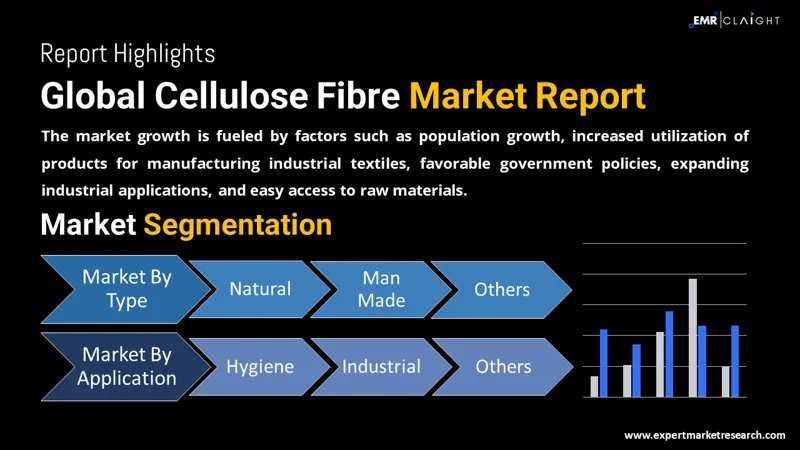
Consumer Insights
Uncover trends and behaviors shaping consumer choices today
Procurement Insights
Optimize your sourcing strategy with key market data
Industry Stats
Stay ahead with the latest trends and market analysis.
The global cellulose fibre market is expected to grow at a CAGR of 9.00% in the forecast period of 2026-2035 to attain USD 87.21 Billion by 2035.
Base Year
Historical Period
Forecast Period
Compound Annual Growth Rate
9%
2026-2035
*this image is indicative*
In terms of volume, Asia-Pacific is the largest market for cellulose fibre in the world. The demand for textiles in this area is being driven by a growing population and a rising standard of living. Textiles are commonly made from cellulose fibres, both natural and synthetic. The main applications expected to drive market growth in the Asia Pacific region in the coming years are apparel and home textile.

Read more about this report - REQUEST FREE SAMPLE COPY IN PDF
Natural cellulose fibres and man-made cellulose fibres are the two types of cellulose fibres that are commonly used. Cotton, jute, and other natural cellulose fibres are examples of natural cellulose fibres, while viscose, lyocell, modal, and other man-made cellulose fibres are examples of man-made cellulose fibres. The rising demand for various cellulose fibres is aiding the market growth.

Read more about this report - REQUEST FREE SAMPLE COPY IN PDF
Cellulose fibres are fibres that are made from cellulose found in wood pulp or plant stalks. These fibres are naturally versatile and have unusual and useful properties such as moisture absorption and hydrophobicity.
The market is bifurcated on the basis of type into:
The natural segment is divided on the basis of type into cotton, and jute, among others, whereas man made segment is divided on the basis of type into viscose, acetate, lyocell, and modal, among others.
In terms of application, the market is divided into:
In terms of region, the market is divided into:
The cellulose fibres market is being driven by rising demand for eco-friendly and biodegradable fibres, especially in the textile and hygiene industries. The industrial processing of wood pulp derived from botanical sources is used in the manufacture of synthetic or man-made fibres. The manufacture of cellulose fibres, on the other hand, necessitates the mechanical and chemical processing of wood pulp. The most popular rayon types are viscose, triacetate, and acetate, which are man-made cellulose fibres used widely throughout end-use industries. The cellulose fibre production requires high-capital and specialised knowledge. The key market players are actively working on new products and technological advances through research and development, which is expected to boost the market in the forecast period.
The report gives a detailed analysis of the following key players in the global cellulose fibre market, covering their competitive landscape, capacity, and latest developments like mergers, acquisitions, and investments, expansions of capacity, and plant turnarounds:
The comprehensive EMR report provides an in-depth assessment of the market based on the Porter's five forces model along with giving a SWOT analysis.




*While we strive to always give you current and accurate information, the numbers depicted on the website are indicative and may differ from the actual numbers in the main report. At Expert Market Research, we aim to bring you the latest insights and trends in the market. Using our analyses and forecasts, stakeholders can understand the market dynamics, navigate challenges, and capitalize on opportunities to make data-driven strategic decisions.*
Get in touch with us for a customized solution tailored to your unique requirements and save upto 35%!
The global cellulose fibre market is projected to grow at a CAGR of 9.00% between 2026 and 2035.
The increasing population, surging product utilisation in manufacturing industrial textiles, the implementation of favourable government policies aimed at expanding industrial applications, and easy availability of raw materials of cellulose fibre are the major market drivers.
The rising demand for eco-friendly and biodegradable fibres in the textile sector and technological advancements and innovations are the key trends propelling the market growth.
The major regions in the market are North America, Latin America, Europe, the Middle East and Africa, and the Asia Pacific.
The various types of cellulose fibre include natural and man made.
The various applications of cellulose fibre are textile, hygiene, and industrial, among others.
The major players in the market are Lenzing AG, Grasim Industries Limited, Fulida Group Holding Co. Ltd, CFF GmbH & Co. KG, Eastman Chemical Company, and Metsä Group, among others.
Explore our key highlights of the report and gain a concise overview of key findings, trends, and actionable insights that will empower your strategic decisions.
| REPORT FEATURES | DETAILS |
| Base Year | 2025 |
| Historical Period | 2019-2025 |
| Forecast Period | 2026-2035 |
| Scope of the Report |
Historical and Forecast Trends, Industry Drivers and Constraints, Historical and Forecast Market Analysis by Segment:
|
| Breakup by Type |
|
| Breakup by Application |
|
| Breakup by Region |
|
| Market Dynamics |
|
| Competitive Landscape |
|
| Companies Covered |
|
| Report Price and Purchase Option | Explore our purchase options that are best suited to your resources and industry needs. |
| Delivery Format | Delivered as an attached PDF and Excel through email, with an option of receiving an editable PPT, according to the purchase option. |
Datasheet
One User
USD 2,499
USD 2,249
tax inclusive*
Single User License
One User
USD 3,999
USD 3,599
tax inclusive*
Five User License
Five User
USD 4,999
USD 4,249
tax inclusive*
Corporate License
Unlimited Users
USD 5,999
USD 5,099
tax inclusive*
*Please note that the prices mentioned below are starting prices for each bundle type. Kindly contact our team for further details.*
Flash Bundle
Small Business Bundle
Growth Bundle
Enterprise Bundle
*Please note that the prices mentioned below are starting prices for each bundle type. Kindly contact our team for further details.*
Flash Bundle
Number of Reports: 3
20%
tax inclusive*
Small Business Bundle
Number of Reports: 5
25%
tax inclusive*
Growth Bundle
Number of Reports: 8
30%
tax inclusive*
Enterprise Bundle
Number of Reports: 10
35%
tax inclusive*
How To Order

Select License Type
Choose the right license for your needs and access rights.

Click on ‘Buy Now’
Add the report to your cart with one click and proceed to register.

Select Mode of Payment
Choose a payment option for a secure checkout. You will be redirected accordingly.
Gain insights to stay ahead and seize opportunities.

Get insights & trends for a competitive edge.

Track prices with detailed trend reports.

Analyse trade data for supply chain insights.

Leverage cost reports for smart savings

Enhance supply chain with partnerships.

Connect For More Information
Our expert team of analysts will offer full support and resolve any queries regarding the report, before and after the purchase.
Our expert team of analysts will offer full support and resolve any queries regarding the report, before and after the purchase.
We employ meticulous research methods, blending advanced analytics and expert insights to deliver accurate, actionable industry intelligence, staying ahead of competitors.
Our skilled analysts offer unparalleled competitive advantage with detailed insights on current and emerging markets, ensuring your strategic edge.
We offer an in-depth yet simplified presentation of industry insights and analysis to meet your specific requirements effectively.
Share